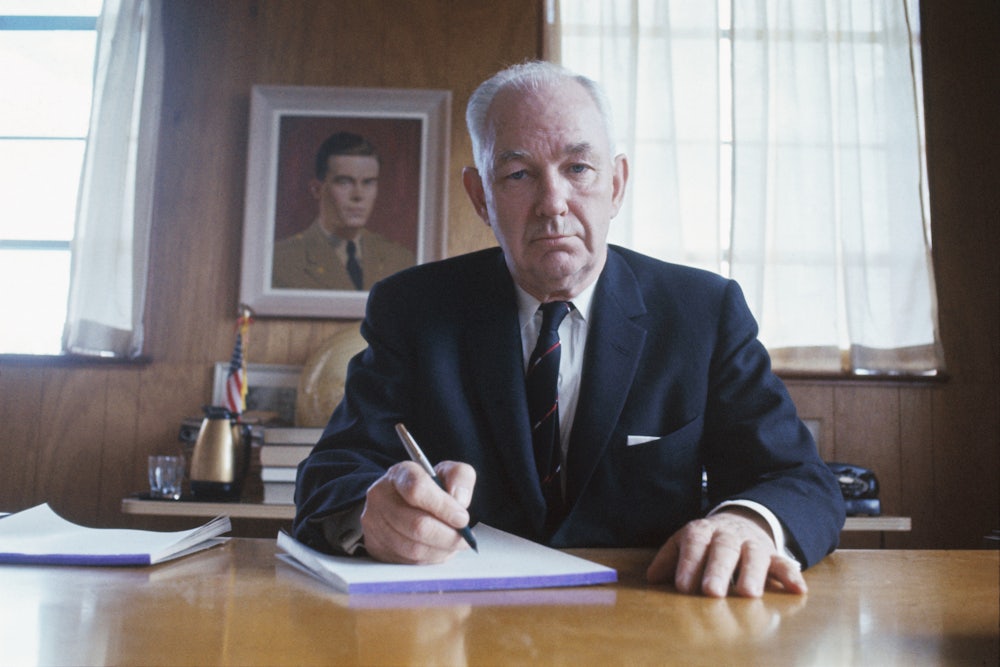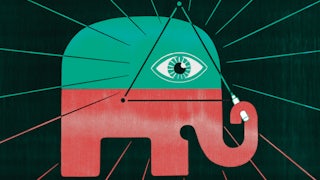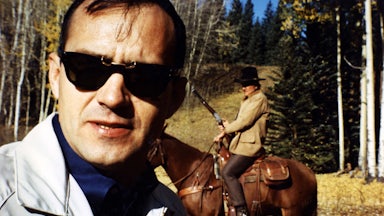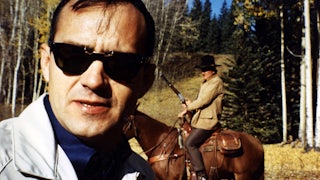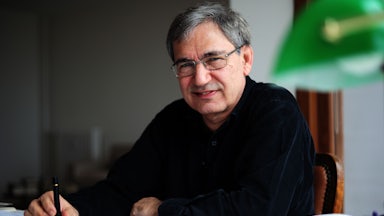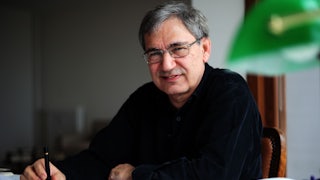In August 1945, as World War II drew to a close, a wealthy candy manufacturer named Robert Welch had a dark vision of the future. That month a Baptist missionary and Office of Strategic Services officer named John Birch was killed by Communists in China. His death, Welch believed, marked “the first casualty in the Third World War between communists and the ever-shrinking free world.” When Welch founded the John Birch Society 13 years later to “safeguard the Constitution,” he named the organization in his honor.
Welch had become increasingly alarmed by the direction of American politics and believed internal threats lurked in top government posts, schools, the military, and mass media. Birchers went well beyond the McCarthyite sentiments of the day, outlining a sweeping global conspiracy wherein the United Nations, the Soviet Union, big banks, the Civil Rights Movement, feminists, labor unions, Dwight Eisenhower’s presidency, and the welfare state were all implicated in a left-wing plot to impose “one world government.”
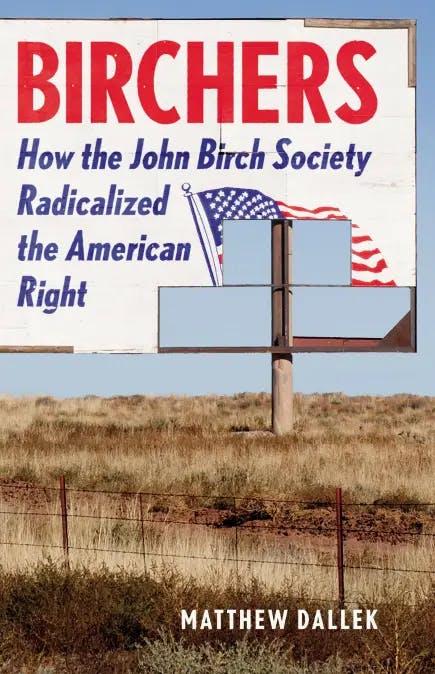
During their most active years, Birchers formed dozens of chapters across the country. Their predominantly wealthy, white Christian membership was looking for a vehicle outside of the two-party system with which to make an impact. Members operated in relative secrecy and independence, organizing letter-writing campaigns to lawmakers, running for school board elections, and rallying behind local causes. Members fought against civil rights legislation, school integration, sex education, taxes, and public health measures like water fluoridation, which they believed was a plot to poison Americans. They self-published right-wing literature, hosted talk radio shows, and grew through word-of-mouth referrals. The John Birch Society pioneered the use of front groups to shape public opinion and policy, and counted Fred Koch of Koch Industries among its founding members.
The John Birch Society was never the center of a large movement. Yet today the form of conspiracy mongering that it pioneered has become the dominant mode on the American right, flourishing in book bans, Covid disinformation, QAnon, on Fox News, and at Infowars. Trump made it to the White House by echoing Bircher talking points and has used them to accuse Democrats and the “deep state” of a conspiracy against him. In late March this year, Don Jr. described his father’s indictment as “communist-level shit” worthy of Mao, Stalin, and Pol Pot.
I recently spoke with historian Matthew Dallek, whose new book, Birchers: How the John Birch Society Radicalized the American Right, documents how the far right moved from the fringe to the center of conservative politics. During our conversation, which has been edited for length and clarity, we discussed how the Birchers paved the way for Trumpism and the lessons that liberals can learn from the past.
Indigo Olivier: You’re one of several writers who’ve focused on the John Birch Society in recent years. Rick Perlstein recently wrote about its legacy, and Edward Miller’s biography of Robert Welch came out in 2021. There has been a moment of rediscovery. Why do you think the Birchers were somewhat forgotten for so long?
Matthew Dallek: I think most Americans and most historians did not expect extremists to engulf much of the conservative movement or to engulf the Republican Party. For a long time, the fringe seemed confined to the margins of American politics to most people. And the assumption, even within the Republican Party, was that if you went too far to the fringe, if you embraced conspiracy theories, if you railed against immigrants as rapists and criminals, if you called for America to withdraw from much of the world, and oppose free trade, and all the positions and ideas that MAGA has embodied and promoted, that those things would be losers. They would lose, and that was the assumption even heading into the 2016 general election among most Republicans. As Lindsey Graham said, they were going to get “hammered” if Trump was the nominee.
The combination of the collapse of George W. Bush’s presidency, the onset of what I would argue is a more extreme Republican Party, and the realization that Barack Obama’s election did not necessarily represent the progress that I think a lot of liberal historians assumed [it would] were among the forces that came together that have renewed interest in the Birch Society.
I.O.: What elements of the John Birch Society do you see in our current politics?
M.D.: Obviously, it’s not totally a one-to-one comparison, but I see it in many of the tenets that Trump and many of his MAGA supporters hold and promote. A hostility to international organizations and, really, the entire post–World War II international order. America First is a repudiation of an interventionist United States with a strong diplomatic and military presence and military alliances overseas.
I see it in the rejection of immigration and in building a wall. Even though the Birchers never took up immigration as a huge issue, they were very suspicious of alien forces being imported from abroad. They made a huge deal of American sovereignty. The idea, as Trump has said, that we’re not going to have a country anymore if it becomes too diluted.
I certainly see it in the conspiracy theories, whether it’s birtherism or fluoride in the drinking water. Birchers had a theory that fluoride was essentially poison and part of a Communist plot; that this was big government forcing people to put poison in their bodies.
And I see it in a more explicit racism. Trump had dinner with Ye and Nick Fuentes a couple months ago. Nick Fuentes, who is a Holocaust denier and white supremacist, recently said that his organization, the Groypers, is really an extension of the Birch Society. He called it a prelude to the Groypers.
The last area is a very hard-line culture-war stance, especially around issues of education, books, and what young people are being taught. The idea that progressive education and a rich exposure to a variety of texts and ideas and perspectives is fundamentally un-American—it tramples on the genius of American history and of the Republic—and that schools and libraries and texts that people are exposed to have to be policed.
I.O.: You observe that the John Birch Society was never, even at its peak, a mass movement. What then did it do that made it so effective?
M.D.: The John Birch Society was founded by a dozen very wealthy businessmen, mostly, in Indianapolis in December 1958. And the group started to recruit members and slowly became active in a handful of hot-button issues. So, protesting a summit between Dwight Eisenhower and Nikita Khrushchev, then launching an impeach Earl Warren campaign to impeach the chief justice. It recruited members fairly successfully and started setting up chapters around the country. They were able to weaponize a controversy time and time again. And they were influential in helping Barry Goldwater secure the presidential nomination in 1964.
Starting in the late 1960s and then into [the] early 1970s, the Birch Society faded as an organization. Ironically, by the time the organization faded, it had established an alternative political tradition and bequeathed an ideological legacy to successors on the far right who would pick up on their ideas. So even though the organization itself shriveled, its legacy lived on.
I.O.: There’s a broader trend recently on the left of trying to understand right-wing ideas and their history with podcasts like Know Your Enemy and a spate of histories of fringe groups and figures. What do you think liberals have to gain from this?
M.D.: Liberals care about democracy and about racial equality and economic justice. All those things are more fragile than a lot of liberals may have assumed a decade ago or 15 years ago. Understanding that fragility and being vigilant can be a very potent mindset for liberals. The sense that things can get worse and can spin out of control domestically, that January 6 may not necessarily be an anomaly. Understanding the forces that threaten democracy is probably important to advancing the liberal project.
I.O.: On the other hand, is there a danger in overemphasizing the similarity of this fringe to today’s right; assuming that we’ve seen all this before? Their behavior seems markedly different from that of the Proud Boys or QAnon, for instance. Do you see important differences?
M.D.: Today’s far right, as I try to show in the book, is much more sophisticated politically. Broadly speaking, the far right in the post–Cold War world has been much more attuned to Republican Party politics and working within the Republican Party as opposed to flirting with third-party runs. The organizational power and funding streams and ability, at least during campaigns, to build alliances is much more sophisticated today than it was for the Birchers.
The far right more recently, let’s say in the past decade, has also been much savvier than the Birchers ever were in capitalizing on contemporary anxieties and political developments. So, for example, capitalizing on an issue like immigration and tapping into that nativist impulse, tapping into the anger in many communities about deindustrialization, the decline of American manufacturing, and the opioid crisis, and this sense that free trade and globalization have contributed mightily to these big problems that have decimated communities. The far right is more sophisticated at tapping into anger that some people, primarily white people, feel about multiracial democracy. I would say that those are certainly some of the significant differences.
What I’m trying to argue in the book is not that the Birchers simply morphed into MAGA but that they provide an ideological template. They bequeathed an ideological legacy and, in some ways, a stylistic one that other successors through the decades have been able to tap into and to use in more sophisticated ways to really advance their cause and achieve power.
The Birchers never really achieved a whole lot of political power. Arguably, the most they did was help Barry Goldwater win the nomination in 1964, but there was never a Bircher in the White House, or at least one that they felt was simpatico with them. They didn’t have any members of Congress in the late ’60s, and then they had two members in the early ’70s who were really seen as the fringiest of the fringe. They did not have the same kind of electoral power or power to affect change that we see today.
I.O.: The John Birch Society saw a swift decline in the 1970s. What would you say led to its downfall?
M.D.: The organization’s heyday was roughly 1959 to 1968. It was roughly a decade. There are a few things. One is that there were institutional checks on the Birch Society, including the mainstream media; the liberal Cold War coalition; civil rights organizations—the NAACP, for example; the unions who helped to establish group resources and track far-right organizations; the Anti-Defamation League, which, as I document, infiltrated the Birch Society and then really sought to expose its darkest impulses and its bigotry.
There were cultural checks as well that took a toll on the movement, that made the movement seem dirty. It made it seem, at least to a lot of Americans, that this was not something you wanted to be associated with. That helped keep it on the fringes. Barry Goldwater’s landslide defeat also helped because Republicans realize that even if they want to harness Bircher energy and Bircher money, they need to be more careful than Goldwater was about it.
The last factor is that Birchers, like a lot of radical groups, imploded from within. These groups that embrace conspiracy theories generally have a tendency to attract people who are increasingly extremist. And over time, the organization itself became more fractious.
I.O.: You started working on this book during the Trump era. We’re now two years into a Democratic administration, and much of the chaos of the previous four years has ebbed. Do you think the legacy of the Birchers is receding?
M.D.: It’s a little too soon to say, especially because the ideas that the Birchers helped promote are still atop much of the Republican Party—whether that’s election denialism, isolationism, conspiracy theories, or explicit racism. Whoever wins the nomination will have to make concessions to the fringe. Kevin McCarthy had to do that.
So I wouldn’t say that Bircher ideas have receded all that much, but I do think that there are some signs that MAGA is having some trouble politically. They lost three straight elections. Republicans have lost seven of the last eight popular votes in presidential elections. And basically all of Trump’s high-profile candidates lost and sometimes lost badly.
